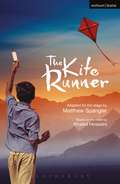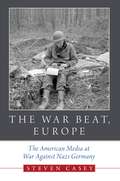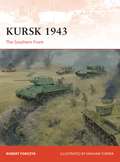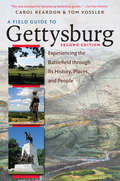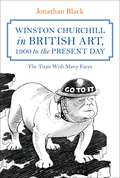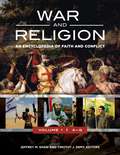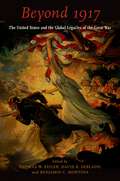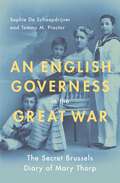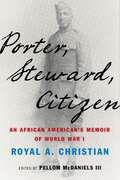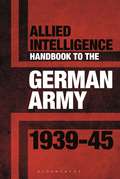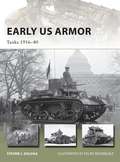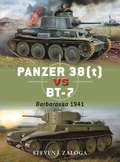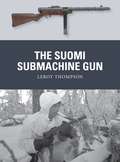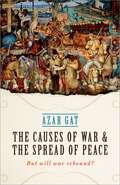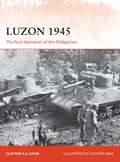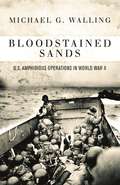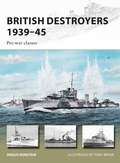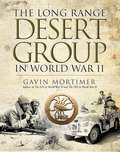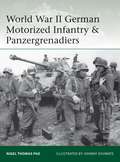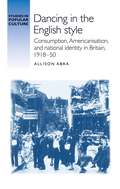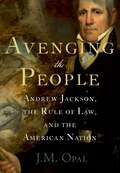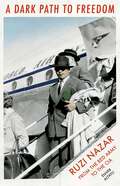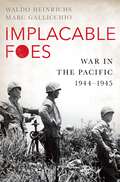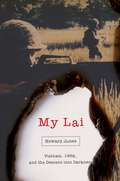- Table View
- List View
The Kite Runner (Modern Plays)
by Khaled Hosseini Matthew SpanglerI became what I am today at the age of twelve. I remember the precise moment, crouching behind a mud wall on a frigid winter day in 1975 . . . looking into a deserted alley. It's wrong what they say about the past, about how you can bury it, because the past claws its way out. I realize I've been looking into that alley for the last 26 years.Afghanistan is a divided country on the verge of war and two childhood friends are about to be torn apart. It's a beautiful afternoon in Kabul and the skies are full of the excitement and joy of a kite flying tournament. But neither Hassan or Amir can foresee the terrible incident which will shatter their lives forever.Khaled Hosseini's first and international best-selling novel has now been adapted into a stunning stage adaptation by Matthew Spangler.This edition was published for the production at Wyndham's Theatre, London, from 21 December 2016.
The War Beat, Europe: The American Media at War Against Nazi Germany
by Steven CaseyFrom the North African desert to the bloody stalemate in Italy, from the London blitz to the D-Day beaches, a group of highly courageous and extremely talented American journalists reported the war against Nazi Germany for a grateful audience. Based on a wealth of previously untapped primary sources, War Beat, Europe provides the first comprehensive account of what these reporters witnessed, what they were allowed to publish, and how their reports shaped the home front's perception of some of the most pivotal battles in American history. In a dramatic and fast-paced narrative, Steven Casey takes readers from the inner councils of government, where Franklin D. Roosevelt and George Marshall held clear views about how much blood and gore Americans could stomach, to the command centers in London, Algiers, Naples, and Paris, where many reporters were stuck with the dreary task of reporting the war by communiqué. At the heart of this book is the epic journey of reporters like Wes Gallagher and Don Whitehead of the Associated Press, Drew Middleton of the New York Times, Bill Stoneman of the Chicago Daily News, and John Thompson of the Chicago Tribune; of columnists like Ernie Pyle and Hal Boyle; and of photographers like Margaret Bourke-White and Robert Capa. These men and women risked their lives on countless occasions to get their dispatches and their images back home. In providing coverage of war in an open society, they also balanced the weighty responsibility of adhering to censorship regulations while working to sell newspapers and maintaining American support for the war. These reporters were driven by a combination of ambition, patriotism, and belief in the cause. War Beat, Europe shows how they earned their reputation as America's golden generation of journalists and wrote the first draft of World War II history for posterity.
Kursk 1943: The Southern Front (Campaign)
by Robert Forczyk Graham TurnerMauled at Stalingrad, the German army looked to regain the initiative on the Eastern Front with a huge offensive launched near the city of Kursk, 280 miles south-west of Moscow. Armed with the new Panther tank, Hitler and Field Marshal von Manstein were confident that they could inflict another crushing defeat on the Soviet Union. What they did not know is that the Soviets knew about the coming attack, and they were ready. This book focuses on the southern front of this campaign, which featured one of the biggest clash of armour of the warin the battle of Prokhorovka which involved over a thousand tanks. It examines in detail the tactics and mistakes of the army commanders as they orchestrated one of the bloodiest battles in World War II. Using campaign maps, stunning photographs and vivid artwork, this new study, a companion to Campaign 272 Kursk 1943: The Northern Front, examines whether that the German offensive was doomed from the start as it takes the reader through this titanic clash of armour.
A Field Guide to Gettysburg, Second Edition Expanded Ebook: Experiencing the Battlefield through Its History, Places, and People
by Carol Reardon Tom VosslerThis special enhanced ebook edition to the newly updated A Field Guide to Gettysburg will lead visitors to every important site across the battlefield and also give them ways to envision the action and empathize with the soldiers involved and the local people into whose lives and lands the battle intruded.. Both Carol Reardon and Tom Vossler are themselves experienced guides who understand what visitors to Gettysburg are interested in, but they also bring the unique perspectives of a scholar and a former army officer. Divided into three day-long tours, this newly improved and expanded edition offers important historical background and context for the reader while providing answers to six key questions: What happened here? Who fought here? Who commanded here? Who fell here? Who lived here? And what did the participants have to say about it later?With new stops, maps, soldier vignettes, and illustrations, the enhanced e-book edition of A Field Guide to Gettysburg adds more human stories to an already impressive work that remains the most comprehensive guide to the events and history of this pivotal battle of the Civil War.
Winston Churchill in British Art, 1900 to the Present Day: The Titan With Many Faces
by Jonathan BlackChurchill is today remembered as a great leader, a war hero, a literary heavyweight and a renowned wit. This incarnation of Churchill is the latest in a long-evolving identity, which at various times has sustained his power, enhanced his popularity and enabled him to personify aspects of British national identity.Indeed Churchill was more aware than most of the performative power of his public life. He lived in an age of the illustrated mass-produced newspaper, with its cartoons and 'Kodak-snappers'. He was well-known for his readiness to appear in uniform for photo opportunities during the Second World War and he not only wrote about the art of political caricature, but collected cartoons of himself, his allies and opponents.In this heavily-illustrated book, Jonathan Black considers the changing image of Churchill in visual art, from cartoons and paintings to photographs and sculptures. He asks how and why his image developed right up to the present day and examines the extent to which Churchill was complicit in its production.
War and Religion [3 volumes]: An Encyclopedia of Faith and Conflict [3 volumes]
This three-volume reference provides a complete guide for readers investigating the crucial interplay between war and religion from ancient times until today, enabling a deeper understanding of the role of religious wars across cultures.Containing some 500 entries covering the interaction between war and religion from ancient times, the three-volume War and Religion: An Encyclopedia of Faith and Conflict provides students with an invaluable reference source for examining two of the most important phenomena impacting society today. This all-inclusive reference work will serve readers researching specific religious traditions, historical eras, wars, battles, or influential individuals across all time periods.The A–Z entries document ancient events and movements such as the First Crusade that began at the end of the 10th century as well as modern-day developments like ISIS and Al Qaeda. Subtopics throughout the encyclopedia include religious and military leaders or other key people, ideas, and weapons, and comprehensive examinations of each of the major religious traditions' views on war and violence are presented. The work also includes dozens of primary source documents—each introduced by a headnote—that enable readers to go directly to the source of information and better grasp its historical significance. The in-depth content of this set benefits high school and college students as well as scholars and general readers.
Beyond 1917: The United States and the Global Legacies of the Great War
A massively destructive and transformative event, the First World War left in its wake many legacies. Beyond 1917 explores both the consequences of the war for the United States (and the world) and American influence on shaping the legacies of the conflict in the decades after US entry in 1917. From the fields, seas, and airspace of battle, we live today with the consequences of the Great War's poison gas, post-traumatic stress disorder, and technological inventions such as air bombardment of civilians, submarine and tank warfare, and modern surgical techniques. Conscription, pacifism, humanitarian campaigns, and socialist movements emerged from the war to shape politics within countries for decades to come. Governments learned the value of propaganda, both in print and in film. Society changed: women were emancipated in some countries and citizenship was altered in many places, while aristocracy and monarchies went into decline. European empires were transformed and in some cases destroyed; in the Middle East, the change was enormous, beginning with the final collapse of Ottoman hegemony in the region. Fascism and communism, mass migration, independence, militarism, an influenza epidemic, the rise of Wall Street and American economic power, a slowdown in the process of globalization, and the pursuit of world peace by an organization based on collective security numbered among the most significant and lasting legacies of this conflict. Beyond 1917 explores how and why the war has become an integral milepost for human history, reflects the importance of the conflict, the forces that led to it, and the forces it unleashed. On the occasion of the centennial commemorations, an international group of scholars considers the long-term policy, political, social, economic, and cultural consequences of the war for the United States itself and for the world. In addition to interpretive essays, the volume provides a comprehensive bibliography and timeline of events.
An English Governess in the Great War: The SEcret Brussels Diary of Mary Thorp
by Sophie De Schaepdrijver Tammy M. ProctorAn Englishwoman of no particular fame living in World War I Brussels started a secret diary in September 1916. Aware that her thoughts could put her in danger with German authorities, she never wrote her name on the diary and ran to hide it every time the "Boches" came to inspect the house. The diary survived the war and ended up in a Belgian archive, forgotten for nearly a century until historians Sophie De Schaepdrijver and Tammy M. Proctor discovered it and the remarkable woman who wrote it: Mary Thorp, a middle-aged English governess working for a wealthy Belgian-Russian family in Brussels. As a foreigner and a woman, Mary Thorp offers a unique window into life under German occupation in Brussels (the largest occupied city of World War I) and in the uncertain early days of the peace. Her diary describes the roar of cannons in the middle of the night, queues for food and supplies in the shops, her work for a wartime charity, news from an interned godson in Germany, along with elegant dinners with powerful diplomats and the educational progress of her beloved charges. Mary Thorp's sharp and bittersweet reflections testify to the daily strains of living under enemy occupation, comment on the events of the war as they unfolded, and ultimately serve up a personal story of self-reliance and endurance. De Schaepdrijver and Proctor's in-depth commentary situate this extraordinary woman in her complex political, social, and cultural context, thus providing an unusual chance to engage with the Great War on an intimate and personal level.
Porter, Steward, Citizen: An African American's Memoir of World War I
by Royal A. ChristianIn 1917, the year the United States entered the Great War, Colonel Moorhead C. Kennedy, one of the most powerful men in the state of Pennsylvania and now the Deputy Director General of Transportation for the American Expeditionary Force, asked his African American valet if he would like to accompany him on an overseas mission. The valet's reaction was "Yes, sir." And he, as he recounted years later, "at once had visions of France." So began Royal Christian's odyssey in Europe. After a tumultuous crossing of the Atlantic as a third class steward on board a British steamship, he survived London's aerial bombing and then celebrated the end of the war in that city's streets. At last, he reached the long anticipated Paris, where he could admire the Eiffel Tower and the astonishing windows of Notre Dame. Royal Christian chronicled his extraordinary experiences in a memoir, Roy's Trip to the Battlefields of Europe, that was privately published in 1919. Rich in historical details, cultural observations, and political reflections, this book is a vital testimony to the history of African American men participating in World War I. After almost a century, Pellom McDaniels III has unearthed this gem, providing an elegantly annotated edition of Christian's memoir. Porter, Steward, Citizen nods both directly and indirectly to the challenges that African Americans encountered in their efforts to serve the cause of freedom and democracy, even as they were denied access to those rights by Jim Crow laws at home. Christian's unique story vividly illustrates how the war helped African American men claim a sense of manhood tied to their military service, and their efforts to transform themselves and their families into full-fledged American citizens. While race often served as a barrier in the army, this book suggests that some black men managed to take advantage of their outsider-within status and thrive: elevating not only themselves but also their community within a society that maintained a deep and abiding attachment to the myth of white supremacy.
Allied Intelligence Handbook to the German Army 1939–45
by Stephen BullWhat did the British or American soldier know about the German Army? Was this knowledge accurate - and just how did he know it? There have been several 'handbooks' of Second World War armies, but they never tell us exactly what the Allied soldier knew at the time, or how he was informed. This is of importance because it influenced both conduct on the battlefield, and the way in which the soldier thought about his enemy. The book explains the background history of the organisations involved, followed by short chapters based around a series of original documents. This puts the original into context and also discusses whether the document that follows was correct in the picture it painted, and what can be deduced about sources and the concerns of the intelligence officers who compiled the material. Most of the documents were produced at the time, by the British War Office or US War Department, and cover different aspects of the German Army, including tactics, weapons, and uniforms. Subjects include: Allied intelligence on the German Army from 1930 onwards, British SIS / MI6 and US Military Intelligence. The organisations responsible, how they worked, and how they changed very rapidly with the coming of war. The role of technology, modern – like the radio transmitter, ancient – as in scouring libraries and periodicals, reports on military manoeuvres and parades. Limitations of 'Ultra' The German army itself, from the tiny force left after Versailles, to the rapid expansion in the late 1930s. Innovation in tanks, tactics, machine guns, rocket weaponry. The problems of gathering intelligence, not just danger, but finance, asking the right questions and the limitations of reporting and distribution.
Early US Armor: Tanks 1916–40 (New Vanguard)
by Steven J. Zaloga Felipe RodríguezBetween the two World Wars, the US contributed significantly to the development of the tank, a weapon invented by the British and the French seeking a way to break through the lines of German trenches. From the employment of the French Renault FT and British Mark V during their involvement in World War I, the US branched out with their own indigenous designs including the M1 Cavalry Car and the M2 Light and Medium tanks, the precursors to the Stuart and Grant tanks of World War II. Tank designers in this period faced unique challenges and so the story of early American armour is littered with failures amongst the successes. Featuring previously unpublished photos and fully illustrated throughout, Early American Armor (1): Tanks 1916–40 is essential reading for anyone interested in American armour, or in the development of tank design.
Panzer 38: Barbarossa 1941 (Duel #78)
by Steven J. Zaloga Jim LaurierThe tank battles in the Soviet Union during the summer of 1941 were the largest in World War II, exceeding even the more famous Prokhorovka encounter during the Kursk campaign. Indeed, they were the largest tank battles ever fought. This book examines two evenly matched competitors in this conflict, the German Panzer 38(t) and the Soviet BT-7. Both were of similar size, armed with guns of comparable firepower, and had foreign roots – the Panzer 38(t) was a Czechoslovak design and the BT-7 was an evolution of the American Christie tank. With full-colour artwork and archive and present-day photography, this absorbing study assesses the strengths and limitations of these two types against the wider background of armoured doctrine in the opening stages of Operation Barbarossa.
The Suomi Submachine Gun (Weapon)
by Adam Hook Leroy Thompson Alan GillilandEntering service in 1931, the 9x19mm Suomi KP/-31 submachine gun saw extensive combat with Finnish troops during their fight against Soviet forces in 1939–44. It was also manufactured under licence in Switzerland, Denmark and Sweden, and remained in Finnish service until the 1980s, an indication of its durability.Rugged and accurate, the Suomi was a favourite with Finnish ski troops who would strike from ambush, cutting down Soviet troops, then skiing away into the woods. Initially used by the Finns as a light machine gun at infantry squad level, it eventually became a dedicated submachine gun, and since it had been designed to be more accurate than the typical SMG, it was often even used as a sniping weapon, or to supplement longer-ranged rifles such as the Mosin-Nagant. Featuring first-hand accounts and specially commissioned colour artwork, this is the story of one of World War II's most distinctive and respected infantry weapons.
The Causes of War and the Spread of Peace: But Will War Rebound?
by Azar GatAzar Gat sets out to resolve one of the age-old questions of human existence: why people fight and can they stop. Spanning warfare from prehistory to the 21st century, the book shows that, neither an irresistible drive nor a cultural invention, deadly violence and warfare have figured prominently in our behavioural toolkit since the dawn of our species. People have always alternated between cooperation, peaceful competition, and violence to attain evolution-shaped human desires. A marked shift in the balance between these options has occurred since the onset of the industrial age. Rather than modern war becoming more costly (it hasn't), it is peace that has become more rewarding. Scrutinizing existing theories concerning the decline of war - such as the 'democratic peace' and 'capitalist peace' - Gat shows that they in fact partake of a broader Modernization Peace that has been growing since 1815. By now, war has disappeared within the world's most developed areas. Finally, Gat explains why the Modernization Peace has been disrupted in the past, as during the two World Wars, and how challenges to it may still arise. They include claimants to alternative modernity - such as China and Russia - anti-modernists, and failed modernizers that may spawn terrorism, potentially unconventional. While the world has become more peaceful than ever before, there is still much to worry about in terms of security and no place for complacency.
Luzon 1945: The final liberation of the Philippines (Campaign #306)
by Clayton Chun Giuseppe RavaDriven from the Philippines in 1942, General Douglas MacArthur returned three years later to force the Japanese off of its main island of Luzon. Containing the capital of Manila, vital natural resources as well as thousands of Allied prisoners of war, the triumph at Luzon would be a vital step on the road to victory as the Americans continued to island-hop their way towards the Japanese home islands. This new study details one of the hardest-fought campaigns of the Pacific War with Japanese fatalities alone on Luzon topping 200,000. Emphasizing the differences in Japanese and American strategy, and detailing the combat operations of the campaign, this volume tells the story of how MacArthur kept his promise to return and liberate the Philippines.
Bloodstained Sands: U.S. Amphibious Operations in World War II
by Michael G. WallingFor the men who served in America's Amphibious Forces during World War II, the conflict was an unceasing series of D-Days. They were responsible for putting men ashore in more than 200 landings throughout the conflict, most against well-entrenched enemy positions. Bloodstained Sands: US Amphibious Operations in World War II tells the story of these forgotten men for the first time, tracing their operational history from Guadalcanal to Casablanca, Sicily, Normandy, Iwo Jima and finally Okinawa. The men's stories are told in their own voices, with fascinating accounts from Underwater Demolition Teams, Attack Transport crews and many other unsung heroes of World War II.First-hand interviews, entries from personal diaries and Action Reports create a unique history, perfectly complemented by historic illustrations and detailed maps. These are timeless tales of determination, sacrifice, and triumph of the human spirit - tales of US Amphibious Forces that for too long have gone forgotten and untold.
British Destroyers 1939–45: Pre-war classes (New Vanguard #246)
by Angus KonstamThe Royal Navy entered World War II with a large but eclectic fleet of destroyers. Some of these were veterans of World War I, fit only for escort duties. Most though, had been built during the inter-war period, and were regarded as both reliable and versatile. Danger though lurked across the seas as new destroyers being built in Germany, Italy and Japan were larger and better armoured. So, until the new, larger Tribal-class destroyers could enter service, these vessels would have to hold the line. Used mainly to hunt submarines, protect convoys from aerial attack, and take out other destroyers, these ships served across the globe during the war. This fully illustrated study is the first in a two-part series on the real workhorses of the wartime Royal Navy, focusing on how these ageing ships took on the formidable navies of the Axis powers.
Lancaster
by Bloomsbury PublishingThe star of the famous 'Dambusters' raid, the Avro Lancaster also formed the backbone of the RAF's Bomber Command during the large-scale night bombing campaign against occupied Europe during World War II. Unable to hit back on the ground, with the Lancaster, Britain could take the fight to Germany. This complete illustrated guide to one of Britain's most iconic aircraft explores its history, strengths, weaknesses and combat performance in the war that would make it legendary. Featuring stunning artwork and contemporary photographs, this book reveals how the Lancaster became the RAF's most successful heavy bomber of the war, and a symbol of British resistance and air power.
The Long Range Desert Group in World War II
by Gavin MortimerFormed in June 1940 for the purpose of gathering intelligence behind enemy lines, the Long Range Desert Group (LRDG) played a secretive but vital role in North Africa during World War II. Highly trained in mechanized reconnaissance and specializing in desert operations, the unit provided support to the Special Air Service (SAS) in missions across the vast and treacherous terrain of the Western Desert. In this highly illustrated history of the LRDG, Gavin Mortimer reveals the origins and dramatic operations of Britain's first ever special forces unit.
World War II German Motorized Infantry & Panzergrenadiers (Elite)
by Johnny Shumate Nigel ThomasIn World War II Germany's doctrine of mobile warfare dominated the battlefield. By trial and error, the Germans were the first to correctly combine the strength in tanks and in mobile infantry and artillery. This integration of mobile units, equipment and tactics underpinned Germany's successes in the first half of the war. As the war dragged on, the Allies sought to copy German tactics but German armies remained supreme in this type of warfare until their losses had seriously degraded their capabilities. This study traces the development of the different types of unit that came together in the Panzergrenadier branch from the inter-war years through World War II. Using colour plates to display the changes in uniform, equipment and insignia in all theatres of operations throughout the conflict, this is a complete account of Hitler's elite armoured infantry.
Dancing in the English style: Consumption, Americanisation and national identity in Britain, 1918–50 (Studies in Popular Culture)
by Allison AbraThis book illuminates the history of popular dance, one of the most influential and widespread leisure practices in early twentieth-century Britain. It focuses in particular on the relationship between dancing and national identity construction, in a period when Britain participated in increasingly global markets of popular cultural production, consumption, and exchange.
Avenging the People: Andrew Jackson, the Rule of Law, and the American Nation
by J.M. OpalMost Americans know Andrew Jackson as a frontier rebel against political and diplomatic norms, a "populist" champion of ordinary people against the elitist legacy of the Founding Fathers. Many date the onset of American democracy to his 1829 inauguration. Despite his reverence for the "sovereign people," however, Jackson spent much of his career limiting that sovereignty, imposing new and often unpopular legal regimes over American lands and markets. He made his name as a lawyer, businessman, and official along the Carolina and Tennessee frontiers, at times ejecting white squatters from native lands and returning slaves to native planters in the name of federal authority and international law. On the other hand, he waged total war on the Cherokees and Creeks who terrorized western settlements and raged at the national statesmen who refused to "avenge the blood" of innocent colonists. During the long war in the south and west from 1811 to 1818 he brushed aside legal restraints on holy genocide and mass retaliation, presenting himself as the only man who would protect white families from hostile empires, "heathen" warriors, and rebellious slaves. He became a towering hero to those who saw the United States as uniquely lawful and victimized. And he used that legend to beat back a range of political, economic, and moral alternatives for the republican future. Drawing from new evidence about Jackson and the southern frontiers, Avenging the People boldly reinterprets the grim and principled man whose version of American nationhood continues to shape American democracy.
A Dark Path to Freedom: Rusi Nazar from the Red Army to the CIA
by Enver AltayliBorn in Margilan, Central Asia on the eve of the Russian Revolution of 1917, Ruzi Nazar had one of the most exciting lives of the twentieth century. Charming, intellectually brilliant and passionately committed to the liberation of Central Asia from Russian rule, his life was a series of adventures and narrow escapes. He was successively a Soviet student, a Red Army officer, an officer in the German Turkestan Legion during World War II, a fugitive living in postwar Germany's underworld, and finally an immigrant to the United States who rose high in the CIA. Here he mixed with the powerful and famous, represented the US as a diplomat in Ankara and Bonn, and became an undercover agent in Iran after the hostage crisis of 1979-81. Nazar's foresight was formidable. He predicted that communism would collapse from within, briefing Reagan on the weakness of the Soviet system before the Reagan-Gorbachev talks. A Muslim who rejected Islamism, his warnings to the US government about the dangers of Islamic radicalism fell on deaf ears. This remarkable biography casts unique light on the lives of people caught up in the turmoil of the Soviet Union, World War II, the Cold War, and the struggle of nationalities deprived of their freedom by communism to regain independence.
Implacable Foes: War in the Pacific, 1944-1945
by Waldo Heinrichs Marc GallicchioOn May 8, 1945, Victory in Europe Day-shortened to "V.E. Day"-brought with it the demise of Nazi Germany. But for the Allies, the war was only half-won. Exhausted but exuberant American soldiers, ready to return home, were sent to join the fighting in the Pacific, which by the spring and summer of 1945 had turned into a gruelling campaign of bloody attrition against an enemy determined to fight to the last man. Germany had surrendered unconditionally. The Japanese would clearly make the conditions of victory extraordinarily high. In the United States, Americans clamored for their troops to come home and for a return to a peacetime economy. Politics intruded upon military policy while a new and untested president struggled to strategize among a military command that was often mired in rivalry. The task of defeating the Japanese seemed nearly unsurmountable, even while plans to invade the home islands were being drawn. Army Chief of Staff General George C. Marshall warned of the toll that "the agony of enduring battle" would likely take. General Douglas MacArthur clashed with Marshall and Admiral Nimitz over the most effective way to defeat the increasingly resilient Japanese combatants. In the midst of this division, the Army began a program of partial demobilization of troops in Europe, which depleted units at a time when they most needed experienced soldiers. In this context of military emergency, the fearsome projections of the human cost of invading the Japanese homeland, and weakening social and political will, victory was salvaged by means of a horrific new weapon. As one Army staff officer admitted, "The capitulation of Hirohito saved our necks." In Implacable Foes, award-winning historians Waldo Heinrichs (a veteran of both theatres of war in World War II) and Marc Gallicchio bring to life the final year of World War Two in the Pacific right up to the dropping of the atomic bombs over Hiroshima and Nagasaki, evoking not only Japanese policies of desperate defense, but the sometimes rancorous debates on the home front. They deliver a gripping and provocative narrative that challenges the decision-making of U.S. leaders and delineates the consequences of prioritizing the European front. The result is a masterly work of military history that evaluates the nearly insurmountable trials associated with waging global war and the sacrifices necessary to succeed.
My Lai: Vietnam, 1968, and the Descent into Darkness (Pivotal Moments in American History)
by Howard JonesOn the early morning of March 16, 1968, American soldiers from three platoons of Charlie Company (1st Battalion, 20th Infantry Regiment, 11th Brigade, 23rd Infantry Division), entered a group of hamlets located in the Son Tinh district of South Vietnam, located near the Demilitarized Zone and known as "Pinkville" because of the high level of Vietcong infiltration. The soldiers, many still teenagers who had been in the country for three months, were on a "search and destroy" mission. The Tet Offensive had occurred only weeks earlier and in the same area and had made them jittery; so had mounting losses from booby traps and a seemingly invisible enemy. Three hours after the GIs entered the hamlets, more than five hundred unarmed villagers lay dead, killed in cold blood. The atrocity took its name from one of the hamlets, known by the Americans as My Lai 4. Military authorities attempted to suppress the news of My Lai, until some who had been there, in particular a helicopter pilot named Hugh Thompson and a door gunner named Lawrence Colburn, spoke up about what they had seen. The official line was that the villagers had been killed by artillery and gunship fire rather than by small arms. That line soon began to fray. Lieutenant William Calley, one of the platoon leaders, admitted to shooting the villagers but insisted that he had acted upon orders. An exposé of the massacre and cover-up by journalist Seymour Hersh, followed by graphic photographs, incited international outrage, and Congressional and U.S. Army inquiries began. Calley and nearly thirty other officers were charged with war crimes, though Calley alone was convicted and would serve three and a half years under house arrest before being paroled in 1974. My Lai polarized American sentiment. Many saw Calley as a scapegoat, the victim of a doomed strategy in an unwinnable war. Others saw a war criminal. President Nixon was poised to offer a presidential pardon. The atrocity intensified opposition to the war, devastating any pretense of American moral superiority. Its effect on military morale and policy was profound and enduring. The Army implemented reforms and began enforcing adherence to the Hague and Geneva conventions. Before launching an offensive during Desert Storm in 1991, one general warned his brigade commanders, "No My Lais in this division--do you hear me?" Compelling, comprehensive, and haunting, based on both exhaustive archival research and extensive interviews, Howard Jones's My Lai will stand as the definitive book on one of the most devastating events in American military history.
